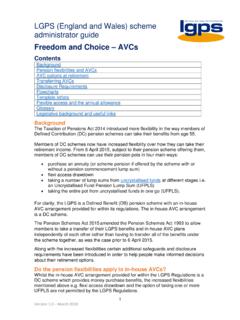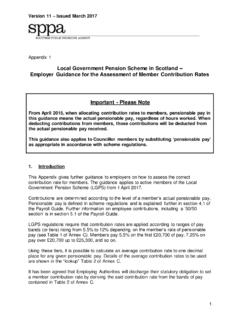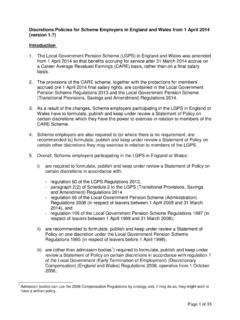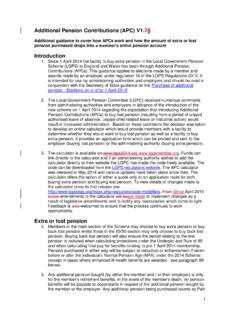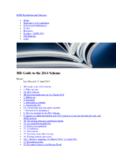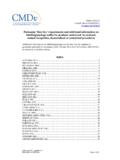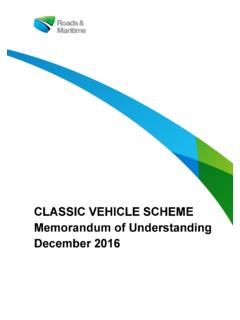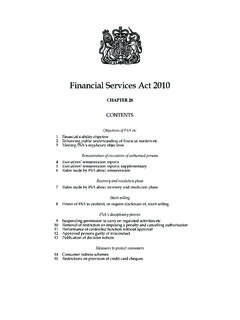Transcription of Additional Pension Contributions (APC) V1 - lgpslibrary.org
1 Additional Pension Contributions (APC) Additional guidance to cover how APCs work and how the amount of extra or lost Pension purchased drops into a member's active Pension account Introduction 1. Since 1 April 2014 the facility to buy extra Pension in the Local Government Pension Scheme (LGPS) in England and Wales has been through Additional Pension Contributions (APCs). This guidance applies to elections made by a member and awards made by an employer under regulation 16 of the LGPS Regulations 2013. It is intended for use by administering authorities and employers and should be read in conjunction with the Secretary of State guidance on the 'Purchase of Additional Pension - Elections on or after 1 April 2014'. 2. The Local Government Pension Committee (LGPC) received numerous comments from administering authorities and employers in advance of the introduction of the new scheme on 1 April 2014 regarding the expectation that introducing Additional Pension Contributions (APCs) to buy lost Pension (resulting from a period of unpaid authorised leave of absence, unpaid child related leave or industrial action) would result in increased administration.
2 Based on these comments the decision was taken to develop an online calculator which would provide members with a facility to determine whether they would want to buy lost Pension as well as a facility to buy extra Pension . It provides an application form which can be printed and sent to the employer (buying lost Pension ) or the administering authority (buying extra Pension ). 3. The calculator is available on Funds can link directly to the calculator and if an administering authority wishes to add the calculator directly to their website the LGPC has made the code freely available. The code can be downloaded from the LGPS regulations website. The APC calculator was released in May 2014 and various updates have taken place since then. The calculator offers the option of either a quote only or an application route for both buying extra Pension and buying lost Pension .
3 To view details of changes made to the calculator since its first release see Since April 2015 amendments to the calculator are made to implement changes as a result of legislative amendments and to rectify any inaccuracies which come to light. Feedback is welcomed to ensure that the process continues to work appropriately. Extra or lost Pension 4. Members in the main section of the Scheme may choose to buy extra Pension or buy back lost Pension whilst those in the 50/50 section may only choose to buy back lost Pension . Buying back lost Pension will also ensure the period relating to the lost Pension is included when calculating protections under the Underpin and Rule of 85. and when calculating final pay for benefits relating to pre 1 April 2014 membership. Pension purchased in either way will be subject to reduction or enhancement if taken before or after the individual's Normal Pension Age (NPA) under the 2014 Scheme (except in cases where enhanced ill-health benefits are awarded - see paragraph 69.)
4 Below). 5. Any Additional Pension bought (by either the member and / or their employer) is only for the member's retirement benefits. In the event of the member's death, no Pension benefits will be payable to dependants in respect of the Additional Pension bought by the member or the employer. Any Additional Pension being purchased counts as Part D1 (post 31 March 2020 Pension ) and so has an NPA equal to State Pension Age (SPA), or age 65 if later. Please note that, by virtue of regulation 30(7), where a 1. member receives payment of their Pension following termination of their employment on the grounds of redundancy or business efficiency any Additional Pension bought by the employer (or bought by the member) under regulation 16 is subject to actuarial reduction, but Additional Pension bought by the employer under regulation 31 is not subject to actuarial reduction.
5 Thus, if the employer gives 1,000 Additional Pension under regulation 16 at whole cost to the employer it would be subject to an actuarial reduction under regulation 30(7)(a) but if the employer gives 1,000 Additional Pension under regulation 31 at whole cost to the employer it would not be subject to an actuarial reduction under regulation 30(7)(b). 6. If the reason for lost Pension was authorised unpaid leave or unpaid Additional child related leave and the member makes their election to purchase that entire lost Pension within 30 days of returning to work (or such longer period as the employer may allow) the employer must contribute 2/3rds of the cost. The period of absence must be on or after 1 April 2014. Where the member returned to work before 1 April 2014 then the provisions of the LGPS (Administration) Regulations 2008 must apply. If the period spans the 1 April 2014 then the member is best advised not to use the calculator to ensure they cover the full period of absence under both the current regulations and those applying before 1 April 2014.
6 7. Where an election to buy back lost Pension (for authorised unpaid leave or unpaid child related leave) is made more than 30 days after the member returns to work and the employer does not extend this period the cost of buying this lost Pension falls fully to the member (unless the employer voluntarily chooses to contribute towards the cost and, if they do so, they can meet any proportion of the cost). Members can use the buying lost Pension section of the calculator where the election is more than 30. days after they return to work and a warning will be shown to indicate that they will be required to meet the cost in full (unless the employer chooses to extend this 30 day period and the 30 day override box in the Buy Lost Pension field has been ticked). Please note that where a member is buying lost Pension due to a trade dispute the full cost always falls to the member only (unless the employer voluntarily chooses to contribute towards the cost).
7 Only active members can elect to buy lost or extra Pension . In the case of buying lost Pension it may arise that an active member is aware that they will not be returning to work after, for example, a period of authorised leave of absence or unpaid child-related leave but wish to take out a SCAPC to cover that lost Pension . In such cases the LGPS Regulations 2013 do not preclude the option of the active member electing for a SCAPC to cover the lost Pension before they leave that employment. The member could obtain the value of the assumed pensionable pay (APP) for the period of lost Pension and elect to buy the lost Pension by making a SCAPC lump sum payment direct to the administering authority (as they have no pay from which the deduction can be made) and the employer would have to meet their 2/3rds of the cost of the SCAPC. The same principle applies in the case of trade disputes except that this would not be a SCAPC (as the full cost would fall to the member unless the employer voluntarily chooses to contribute towards the cost).
8 In all these cases the election and payment would have to take place whilst the member remained active. 8. To buy lost or extra Pension a member can obtain a quote and an application form from or from their employer or appropriate administering authority. 9. Payment may be by regular deductions from pay, a lump sum deducted from pay or a lump sum paid directly to the administering authority. Those members who are a year or less from their NPA (or those members over their NPA but under age 75). 2. may only pay by means of lump sum (either from pay or direct to the administering authority). 10. When making an application a member must specify the amount they wish to pay /. the amount of Pension they wish to purchase and, if payments are to be made by regular Contributions , the period over which the Contributions are to be paid (but payment by regular Contributions must be over a complete year or number of years and the end date for regular Contributions can be no later than the member's NPA).
9 11. Payment by regular deductions from payroll are to be paid over a number of whole years. The minimum is 1 year, and the maximum is the number of years to the member's NPA (which is equal to the member's SPA, or age 65 if later). 12. If the member has more than one active Pension account ( because the member is in the Scheme in more than one job) the member must specify which account the Additional Pension is to be credited to. If the member wishes to pay Additional Pension Contributions for each job, the member will have to submit separate Additional Pension contribution applications for each job. 13. Where a member is making regular deductions towards an APC arrangement to buy lost or buy extra Pension , that arrangement ceases when: a) The period of the arrangement (a minimum of 1 year and a maximum period to the member's NPA) expires b) The member gives one month's written notice to terminate the arrangement c) The member takes flexible retirement d) The member is no longer an active member of the scheme e) The member leaves the employment (relating to that arrangement), or f) The member dies.
10 In the case of (e) where the member has more than one job ( more than one Pension account) the arrangement will only cease if the job that the member has left is the same job that the Additional Pension was being credited to. An arrangement to buy extra Pension (but not lost Pension ) also ceases when a member makes an election to join the 50/50 section of the scheme. Maximum Pension to be purchased 14. The maximum amount of Additional Pension that may be purchased by a member is 6,7551 from 1st April 2016 (increasing in line with Pensions (Increase) Review orders using a PI date of 1 April 2013). There is also a limit of 6,7552 on the amount of Additional Pension that can be purchased by the employer under regulation 16. (and regulation 31) of the 2013 Regulations. Administrators should ensure they understand these limits and their interaction. 15. Where a member is paying towards an Additional Regular Contribution (ARC).


